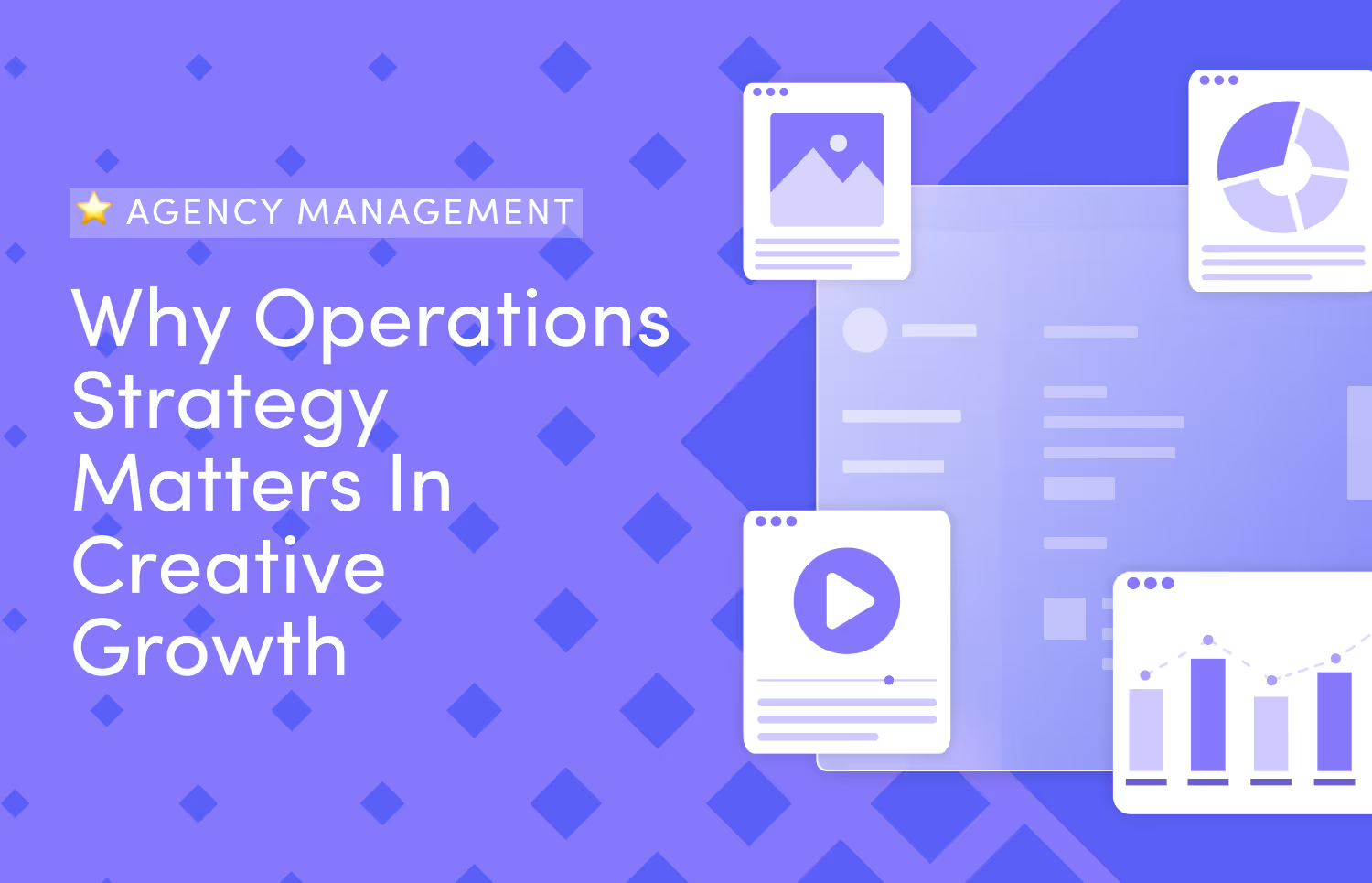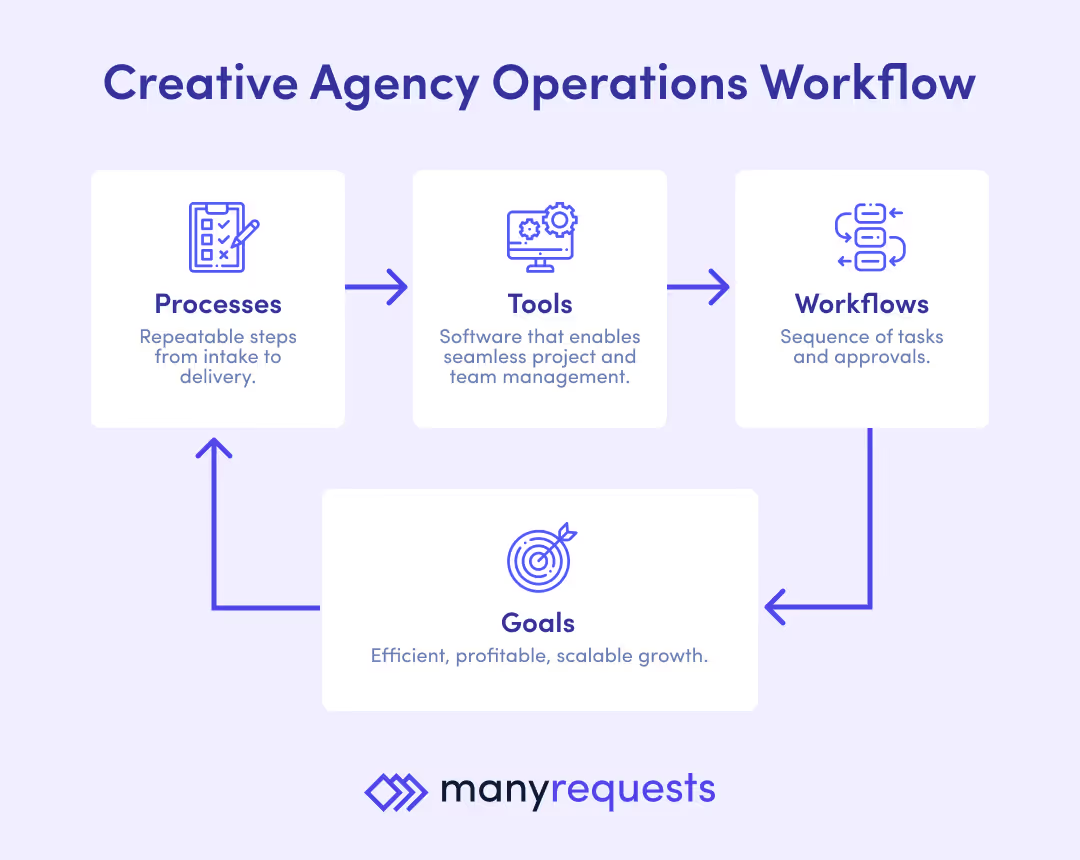Why Operations Strategy Matters in Creative Growth
A solid operations strategy is the foundation for scaling creative agencies - without it, burnout, chaos, and missed deadlines are inevitable.




Are your creative projects consistently over budget and behind schedule? Is team burnout a recurring nightmare, and is your client satisfaction dropping? If your agency's "behind the scenes" feels more chaotic than a well-oiled machine, trust us—you're not alone.
But you don't have to stay stuck. When you're ready to scale, it’s time to stop operating like a startup. This article will reveal the missing piece: a robust operations strategy.

Being part of a creative agency, creativity is your biggest asset—this much is true. But now that you’re managing more projects and clients simultaneously, your creative output is only as strong as its operational backbone.
If you excel at delivering creative value but lack the operational maturity to support growth, the problem boils down to imbalance. While more client work, urgent deadlines, and a backlog of projects seem like a natural byproduct of success, they’re signs of an underdeveloped operations strategy.
At the same time, overemphasizing sales and client acquisition can result in resource shortages, project delays, and burnout. A creative agency with a sales-driven culture can overshadow the importance of operational efficiency and client satisfaction.
Let's expand on this topic because this is where the real pain points lie:
In a service-based industry like creative agencies, meeting deadlines is very critical. Without optimized resource allocation and proper project management strategies, you can anticipate projects often taking longer than expected. You may look successful from the outside—but you are internally fragile and unsustainable.
When there’s financial instability, it’s hard to pay bills and salaries on time. It happens when projects are poorly managed, and your expected revenue takes a hit.
This is the usual effect of a chaotic "behind the scenes." Poor operations mean teams are forced to compensate, and burnout and stress lead to decreased creativity and quality.
In the context of creative agencies, an operations strategy refers to how the agency will organize and manage its resources, processes, and workflows to deliver innovative services effectively and efficiently.
It's about creating a framework to ensure repeatable, profitable, and scalable operations. An effective operations strategy includes these three fundamental building blocks:
A strong operations strategy eliminates redundant work, streamlines project execution, and reduces time spent on non-billable tasks. And that only means:
Growing revenue doesn't always mean taking on more projects. Profitability is better resource allocation, reducing the need for excessive overtime or last-minute hires. More predictable cash flow, as structured workflows ensure that invoices go out on time and payments aren’t delayed.
Scaling an agency without substantial operations often means more stress and inefficiencies. However, teams can handle increased client demand with a solid strategy without overworking. So your agency can expand its offerings without operational breakdowns.
First things first. Your type of operations strategy influences how you implement the key components. How you structure your workflows, allocate resources, and optimize efficiency depends mainly on the type you prioritize.
Here are the key components you must implement that align with your broader operational approach.
Project management determines how efficiently work moves from ideation to delivery. The right approach depends on whether your agency prioritizes speed, quality, customization, or flexibility.
An effective agency operations strategy lets you standardize project execution by defining clear stages for ideation, execution, revision, and delivery. Each project has a well-defined scope, a realistic timeline, and milestone-based progress tracking.
A strong operations strategy includes a financial system that ensures consistent revenue, healthy profit margins, and predictable revenue without financial stress. And your agency’s economic health depends on how well you manage pricing, billing, and cash flow. Ideally, they can move clients to retainer models instead of just one-off projects.
How you assign talent and resources affects both workload balance and profitability. Your operations strategy requires a different approach to team structure and workload management. This means the right people on the right projects at the right time.
Strong client onboarding and communication systems ensure smooth collaboration from the moment a contract is signed, clients should know exactly what to expect. One that reduces friction, minimizes confusion, and builds long-term trust, all of which improve client retention and profitability.
Now, let's discuss the tools that can help your operations strategist. There are many project management software options that can help your agency organize projects, prioritize tasks, and ensure smooth project execution.
ManyRequests is built specifically for creative agencies like yours. It's an all-in-one system that lets you manage everything from project management to client communication and billing in one place. No more switching between apps or dealing with endless email chains. Just streamlined operations, efficient, and it saves you time.
Aside from these three features, ManyRequests offers so much more in project management.
Now, let’s get all these into action. Here’s a step-by-step guide on how to build an operations strategy that supports your long-term growth.
Before improving your operations, you need to pinpoint where inefficiencies exist. Check your current operations and identify any bottlenecks. See if you still work in fragmented workflows and outdated processes. It could be anything from project management to client onboarding. You can start fixing it once you know what's holding you back.
Is everything good from your end now? Then you turn those identified bottlenecks into streamlined, repeatable workflows. You want to create a playbook for your creative agency that anyone can follow. This means setting up Standard Operating Procedures (SOPs) for everything from project intake to client reporting. A major obstacle to scaling is inconsistency.
Next, you need to invest in the right tools—your tech stack. You've already seen some of these tools in action—project management tools like ManyRequests, financial tools like QuickBooks, and automation tools like Zapier. You just have to find the ones that integrate well with each other and support your type of operations strategy.
Finally, you need to continuously monitor, measure, and improve your operations. This means setting up metrics to track performance, identifying areas for improvement, and making adjustments as needed. Examples are the project completion times, client satisfaction scores, revenue per client, and profit margins.
To scale is to grow sustainably. This involves managing creative work efficiently and staying profitable without overwhelming your team. An effective operations strategy makes it easier to control workflows, standardize processes, and use the right tools—collectively, they reduce inefficiencies, improve cash flow, and prevent burnout.
Remember, even minor improvements in operations can result in big over time. So, if you’re ready to streamline your operations, enhance client collaboration, and scale without the growing pains, ManyRequests can help. Sign up for a free trial and run an agency that smoothly grows.